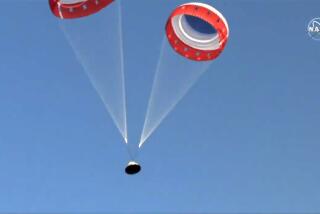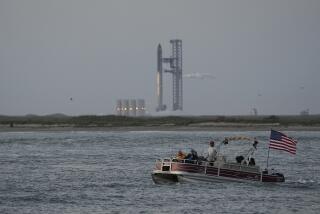Military Shuttle Is Key Part of Pentagon Plan : This Week’s Deployment of Secret Spy Satellite Marks Growing Use of Space by Defense Dept.
WASHINGTON — When the space shuttle Discovery lifts off the launch pad in Florida this week, it will be the first shuttle flight fully dedicated to military purposes and will be shrouded in unprecedented secrecy.
But rather than representing a dramatic departure from the past, Mission 51-C--as the Wednesday launch is called--marks a major step in the Pentagon’s evolving, quarter-century effort to put military men in orbit.
And it highlights the increasing pace at which space has been militarized and the growing breadth of that militarization with unmanned satellites as well.
Vital Fourth Dimension
In the 29 years since the Soviet Union shocked the world by launching Sputnik, space has become a vital fourth dimension--beyond land, sea and air--of potential superpower conflict.
Today, nearly 250 military satellites are circling the Earth, about 150 of them Soviet and the rest American. They take pictures, collect radio signals, map weather, speed communications, watch for nuclear tests, warn of missile attacks and perhaps just play dead--”cold birds” ready to explode near key enemy satellites during a war.
Mission 51-C is expected to add the first of a new generation of electronic eavesdropping satellites--probably the largest and most sophisticated spy satellite yet developed--to that collection.
“Space is no longer a sanctuary,” Air Force Undersecretary Edward C. Aldridge Jr. said in an interview. “U.S. satellites have become essential to national security and must be safeguarded.”
To do that, the United States is pushing to protect the satellites and their ground stations from attack, by “hardening” and giving them maneuvering capabilities, and to develop an anti-satellite weapon to counter the system that the Soviets already have in operation.
But the military’s interest in space goes well beyond that:
--The Pentagon strongly supports President Reagan’s “Star Wars” space defense program to devise laser and other weapons to shield against missile attacks. The Soviet and U.S. efforts to develop space-based beam weapons in some respects have become a grimmer and more expensive replay of the race to land a man on the moon 20 years ago.
--To bring all the military’s space activities under one commander, the Joint Chiefs of Staff are creating a Unified Space Command.
--The Air Force’s chief of staff, Gen. Charles A. Gabriel, believes that “space is the ultimate high ground . . . . The nation’s highest defense priority--deterrence--requires a credible war-fighting capability across the spectrum of conflict,” he wrote in a 1982 forward to the Air Force’s “Military Space Doctrine.”
--The Air Force, as leader of the Pentagon’s space effort, is examining the concept of an aerospace plane (“transatmospheric vehicle”), perhaps to succeed the SR-71 spy plane. It has trained a pool of almost 30 military officers from the three services as “payload specialists” to ride the 16 scheduled military shuttle missions through 1989, and it is building its own shuttle launch and control facilities.
The Soviet military has been even more active in space. It spends twice the money and launches five times more payloads than the Pentagon each year. It has put 10 times more weight in orbit than the United States. It has kept cosmonauts with military missions on orbiting space stations for increasing periods, now almost year-round. And it is preparing for the first flights of its own shuttle and small delta-winged aerospace plane.
This “militarization of space,” though only now receiving a great deal of attention, actually developed gradually and, in retrospect, was probably inevitable. It also seems irreversible and--because it allows the superpowers to monitor arms control pacts and receive early warning of a surprise attack--indispensable.
Media Warned
In the process, the greater military participation has brought greater secrecy to the U.S. space program, culminating last month in the Air Force announcement that it will severely limit information about the first “blue shuttle” flight (blue is the Air Force color) and might investigate offending reporters.
According to reports that appeared before and after the Air Force announcement, Mission 51-C’s payload is a new “elint” (for electronic intelligence) satellite that will be placed in a geostationary orbit above the Equator, where it will intercept radio, radar and other electronic emissions from the western part of the Soviet Union.
Two huge parabolic antennas will protrude from the craft--one to receive Soviet transmissions and the other to relay the collected signals to a distant U.S. communications satellite, which will transmit to a ground station, probably in Australia.
Earlier “elint” satellites, four to six of which continue to function in orbit, have been several times smaller because of the payload limits of expendable booster rockets, such as the Titan. The greater size and weight of the 51-C payload, made possible by the shuttle, undoubtedly mean greater capability for the satellite.
But the satellite also costs a great deal more--perhaps $3 billion, when research, development, the $300-million production cost and launching costs are included--and so relatively fewer of them will be built and put into space. Thus, the Pentagon considers leaks about its mission far more damaging than previously.
Although the shuttle is operated by the civilian National Aeronautics and Space Administration, the Air Force will pay for the entire flight. It has refused to disclose the precise launching and landing times of the Discovery vehicle, details of the payload and in-flight communications.
Hoped to Foil Soviets
The Air Force apparently hoped that the stringent secrecy, unprecedented in the history of U.S. manned space flights, would prevent the Soviets from learning the purpose of the satellite, since “elint” spacecraft are not usually in geosynchronous orbit 22,300 miles high. And, without knowing the shuttle’s exact launching time, the Soviets will have less chance of deducing its mission.
The launching time tells space experts a great deal about likely orbit for which the satellite is destined, and would make it easier for the Soviets to track and photograph the satellite as it emerges from the shuttle in low orbit and is boosted by a second rocket to an altitude too distant for good photographs from the ground.
The space agency announced Friday that countdown preparations for the flight will begin at 4 a.m. Monday, but the exact time of the Wednesday launching remains secret because countdown periods vary in length.
The most sensitive data about the satellite--the radio frequencies to which it will be tuned--remains secret, despite a Washington Post story about the mission that Defense Secretary Caspar W. Weinberger labeled “the height of journalistic irresponsibility.”
The Soviets could easily change frequencies and frustrate the mission, as they have in past situations when leaks disclosed a U.S. capability to intercept conversations from the radio phones in the cars of Kremlin officials.
Aside from the much higher level of Soviet space activity generally, the Soviet and U.S. military efforts have another striking difference: The Soviets use man in space much more.
Soviet space stations were occupied, usually by two-man crews, for just 33 days in 1970-71, for 150 days in 1975-76 and for 286 days in 1981-82, according to an article by Stephen M. Meyer in “Survival,” the magazine of the International Institute for Strategic Studies.
This emphasis grew even more dramatically in 1983-84 when the stations were manned for 388 days, including a record 237-day stretch by a three-man crew last year in a new and larger spacecraft, according to statistics collected by Brown Teledyne Engineering Co. officials in Colorado Springs, Colo.
U.S. Dominance Cited
The Soviets probably use man for spaceflight more than the United States because their instruments are much less reliable than U.S. remote-controlled equipment, the Air Force’s Aldridge said. Military missions account for 75% to 85% of Soviet space activity, and, presumably, the same proportion of manned spaceflight is military related.
The Soviet space station program has “more than a dozen military functions,” according to Aldridge, and is “designed to facilitate the development of a weapons platform.” Among those functions are aiming of surveillance sensors, including cameras and radar, and evaluating man’s ability to select targets from space, he said.
Meyer, a specialist in Soviet military technology at the Massachusetts Institute of Technology, expects that the Soviets will be first to orbit a satellite bearing a laser weapon. “However, it will have little or no military value and will require about a decade or more of incremental improvement before it is capable of carrying out a basic military mission,” he writes.
Those improvements, presumably, will be performed by cosmonauts.
The United States also sees an increasing role for man in space--to repair, refuel and recover satellites. And, since President Reagan announced that the United States will build its own manned space station, the Pentagon is again studying what missions can be performed by man.
The Air Force first proposed sending a military man in space with its Dyna-Soar project, a space “fighter,” in the early 1960s. Later that decade it put forward the Manned Orbital Laboratory concept. But neither project was implemented, largely because technological advances permitted the missions envisaged to be performed cheaper and better by unmanned systems.
Contributions Ill Defined
“We’ve looked at man in space a lot,” Aldridge said. “Conceivably there is a role for military man there, but I can’t say we’ve identified where he could contribute more than a non-manned system in the long run.”
The transatmospheric space plane--which could take off on a runway, achieve orbit and return for landing--is under study as a possible replacement for the SR-71, the 2,000-m.p.h. spy plane that has set an altitude record of 89,000 feet. Such a plane might fly rapid reconnaissance missions when quick film recovery was necessary and the proper equipment was not already in orbit, Aldridge said.
Aldridge also said that the Air Force wants to be prepared to build a huge new booster rocket to launch “Star Wars” satellites if they are developed. The shuttle would still be used for development and testing but a great new unmanned rocket probably will be required to establish a space defense network while holding down costs.
Aldridge sees saving money as the main goal in space in the coming years. If a space-based defense proves feasible, he said, hundreds of launches will be needed per year--compared to 20 to 30 now--to put the required number of satellites in orbit.
“We can’t afford $200 million a launch for the shuttle, or $50 million a launch for the expendable (non-manned) boosters,” he said. “We’ve got to get the cost-to-launch down to, say, $5 million.”
More to Read
Sign up for Essential California
The most important California stories and recommendations in your inbox every morning.
You may occasionally receive promotional content from the Los Angeles Times.










